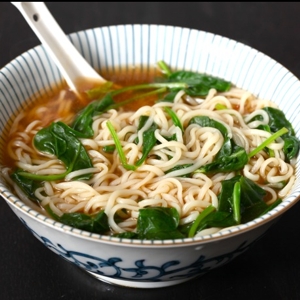People often ask me why Chinese Food became so much more popular in North America than Japanese Food ever did. I cut to the chase and leave them scratching their heads before they can get me wrapped up in interminable discussions. I just tell them, “It’s all because of the railroads…”
 Sushi and Sashimi: Note the examples first and third from
Sushi and Sashimi: Note the examples first and third from
the right; rolled in traditional Nori Seaweed.
That’s about it. too. Many, many Chinese folk came to North America to help build the continental railways in both the U.S. and Canada in the 1880s. Even today, some travellers find it odd that almost every little town along the tracks of the Canadian Pacific Railway from Northern Ontario right out to the BC coast has a Chinese Restaurant, even if it has no other ‘exotic’ eateries.
Like Johnny Appleseed and his trees
Like the legendary Johnny Appleseed and his trees, Chinese restos sprung up everywhere the Chinese migrants who worked on the railways touched ground along the lines. The Chinese folks loved the great, broad, uncrowded country and decided to stay. And Chinese cooks stepped up to provide the kind of food they were used to from ‘back home’. It wasn’t long before Caucasian folks caught on to how good Chinese cuisine, with its noodles and rice, and exotic flavours, could be.
So strongly did Chinese Food catch on in North America, that Canadians and Americans both can boast that some of the ‘Asian’ dishes folks here love so much were actually invented here, by Chinese settlers. Beef with Broccoli stir Fry is just one example. Another is the popularity of Nappa Cabbage in Chinese Cooking. Chinese cooks couldn’t get the kinds pf greens they were used to in North America and had to make substitutions. Now, Nappa is symonymous with North American ‘Chinese’ food. Real Asian Cabbage is actually quite different from Nappa.
Whole styles of ‘Asian’ cooking – notably that which we call ‘Cantonese’ – were actually developed in North America in cities with big Asian communities, such as San Francisco. Two cases in point: Chop Suey and Chow Mein. By the way: Bean Sprouts are not ‘native’ to Asian cooking, either. Chinese cooks who settled in San Francisco are believed to have first cultivated Sprouts, for use in their dishes as cheap, fresh substitutes for something else.
But the Japanese remained aloof
Lacking the taste for constructing railways as their Chinese cousins, Japanese folks stayed home, on their islands, for the most part, until after the Second World War, when their economy was rebuilt largely along industrial lines under the influence of their American occupiers.
This isolation resulted in the preservation of Japanese cuisines in its original form as practiced from medieval times.
Into the big, wide world, at last
Only after the second world war, when American military people brought a taste for Japanese cooking home with them, did it become known in North America has a.) different from Chinese cooking, and b.) something very exotic and enjoyable, did their styles of cooking, use of ingredients and culinary customs become popular. Only since the 1980s and 90s when what we now know as the modern day Foodie emerged from the ranks of the Asia-philes and food snobs, has Japanese cuisine become so popular in North America.
But most folks here still know only what they’ve learned from branded resto chains like Benihana’s, A Taste of Japan, and the fast-growing array of Tappan, Bento and Ramen eateries that are popping up – dare I say?) like Shiitake or Enoki mushrooms after a rain.
Japanese styles you probably already know
Among the styles of Japanese cuisine we’re now generally used to:
Ramen: Noodle Soup dishes (See photo, top of page.)
Bento: Different dishes in small servings, usually presented in segmented wooden boxes rather them plated.)
Teppanyaki: Grilled veggies and meats sizzled for minimum periods of time on flat-top grills, often prepared in front of the diner by a skilled, knife-wielding Teppan Chef.)
Sushi: Commonly, cold and/or raw Fish and Seafood, very fresh, served rolled in Sticky Rice and Seaweed sheets, or otherwise arranged as one-or two-bite combos of complementary foods. Dipping Sauces are an import of this style.)
Surimi and Sashimi: Surimi is a style of Fish all its own; usually serv on its own merits. Sashimi is often made from lesser Fish species (commonly Pollack, today), coloured, texaturized and shaped to resemble other, more expensive Seafoods like lobster or crab.
And there are many others, as you’ll discover when exploring the Japanese culinary landscape…
Common Japanese ingredients
Noodles (of course): Notably, the large, thick round-profile Udon noodles found in so many Japanese Soups and other dishes.
Ramen Noodles: Also called ‘Angel Hair’ in other contexts. The unifying base ingredient in the style we call Ramen (Soups) cooking.
Mushrooms: Many uniquely Japanese varieties, eaten fresh or re-hydrated from dry, in Soups, Salads, Stews and other dishes. You may already have heard of or even used Shiitake, Enoki or King Oyster mushrooms. All three are available in most well-stocked supermarket produce departments these days.
Seafood: All kinds, from ubiquitous Shrimp and Fish to exotic and potentially deadly Fugu (Blowfish) specialties.
Seaweed: Nori (the stuff sold in dried sheets, commonly used in Sushi and Salads), Kombu (a key Salad green and Stew ingredient), and Wakami (a signature ingredient in Salads and, and used, famously, in Miso Soup).
Beef: The Japanese are internationally famous for a few breeds of tender, juicy Beef, grown only in small, limited regions, by their own meticulous rules. Kobe is probably the best-known.
And that’s just the bare basics…
… You need to understand and appreciate Japanese cuisine. We’ll look at several styles of Japanese dishes, many of which will probably be new to you, in tomorrow’s post. Get ready for a treat!
~ Maggie J.

